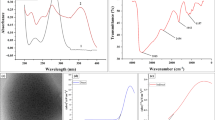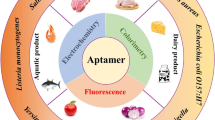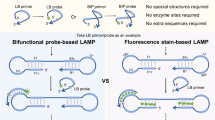Abstract
This study describes an aptamer based assay for the mycotoxin ochratoxin A (OTA). The method is based on the use of an OTA-specific aptamer, exonuclease (Exo) III, SYBR Gold as a fluorescent probe, and a complementary strand that specifically combines with the aptamer. In the presence of OTA, the aptamer and OTA hybridize, thereby resulting in the formation of ssDNA, which is not digested by Exo III. Intense fluorescence is observed after addition of SYBR Gold (best measured at excitation/emission wavelengths of 495/540 nm). Fluorescence increases linearly with the log of the OTA concentration in the range from 8 to 1000 ng·mL−1. The detection limit is 4.7 ng·mL−1. The assay was applied to the determination of OTA in diluted [2%(v/v)] red wine, and recoveries and RSDs ranged between 93.5% and 113.8%, and between 3.2% and 5.7%, respectively.

In the presence of ochratoxin A (OTA), specific combinations of aptamer and OTA may occur and result in DNA double strands being untied, which avoids being digested by Exo III. Intense fluorescence is observed after SYBR Gold addition.




Similar content being viewed by others
References
Zhang C, Tang J, Huang L, Li Y, Tang D (2017) In-situ amplified voltammetric immunoassay for ochratoxin a by coupling a platinum nanocatalyst based enhancement to a redox cycling process promoted by an enzyme mimic. Microchim Acta 184(7):2445–2453
Jodra A, Hervas M, Angel Lopez M, Escarpa A (2015) Disposable electrochemical magneto immunosensor for simultaneous simplified calibration and determination of Ochratoxin a in coffee samples. Sensor Actuators B Chem 221:777–783
Wang B, Wu Y, Chen Y, Weng B, Xu L, Li C (2016) A highly sensitive aptasensor for OTA detection based on hybridization chain reaction and fluorescent perylene probe. Biosens Bioelectron 81:125–130
Guo ZJ, Ren JT, Wang JH, Wang EK (2011) Single-walled carbon nanotubes based quenching of free FAM-aptamer for selective determination of ochratoxin a. Talanta 85(5):2517–2521
Monaci L, Palmisano F (2004) Determination of ochratoxin a in foods: state-of-the-art and analytical challenges. Anal Bioanal Chem 378(1):96–103
Pittet A, Royer D (2002) Rapid, low cost thin-layer chromatographic screening method for the detection of ochratoxin a in green coffee at a control level of 10 mu g/kg. J Agric Food Chem 50(2):243–247
Flajs D, Domijan AM, Ivic D, Cvjetkovic B, Peraica M (2009) ELISA and HPLC analysis of ochratoxin a in red wines of Croatia. Food Control 20(6):590–592
Zhu WY, Ren C, Nie Y, Xu Y (2016) Quantification of ochratoxin a in Chinese liquors by a new solid-phase extraction clean-up combined with HPLC-FLD method. Food Control 64:37–44
Dai S, Wu S, Duan N, Chen J, Zheng Z, Wang Z (2017) An ultrasensitive aptasensor for Ochratoxin a using hexagonal core/shell upconversion nanoparticles as luminophores. Biosens Bioelectron 91(Supplement C):538–544
Wu J, Zhu Y, Xue F, Mei Z, Yao L, Wang X, Zheng L, Liu J, Liu G, Peng C, Chen W (2014) Recent trends in SELEX technique and its application to food safety monitoring. Microchim Acta 181(5–6):479–491
Abnous K, Danesh NM, Alibolandi M, Ramezani M, Taghdisi SM (2017) Amperometric aptasensor for ochratoxin a based on the use of a gold electrode modified with aptamer, complementary DNA, SWCNTs and the redox marker methylene blue. Microchim Acta 184(4):1151–1159
Cetin AE, Coskun AF, Galarreta BC, Huang M, Herman D, Ozcan A, Altug H (2014) Handheld high-throughput plasmonic biosensor using computational on-chip imaging. Light-Sci Appl 3:e122
Taghdisi SM, Danesh NM, Nameghi MA, Ramezani M, Abnous K (2016) A label-free fluorescent aptasensor for selective and sensitive detection of streptomycin in milk and blood serum. Food Chem 203:145–149
Roushani M, Shahdost-fard F (2015) A novel ultrasensitive aptasensor based on silver nanoparticles measured via enhanced voltammetric response of electrochemical reduction of riboflavin as redox probe for cocaine detection. Sensors Actuators B Chem 207:764–771
Zhang D, Ma F, Zhang Q, C-y Z (2017) Highly sensitive detection of epidermal growth factor receptor in lung cancer cells by aptamer-based target−/probe-mediated cyclic signal amplification. Chem Commun 53(83):11496–11499
Li N, Tittl A, Yue S, Giessen H, Song C, Ding B, Liu N (2014) DNA-assembled bimetallic plasmonic nanosensors. Light-Sci Appl 3:e226
Liu K-C, Zhang Z-Y, Shan C-X, Feng Z-Q, Li J-S, Song C-L, Bao Y-N, Qi X-H, Dong B (2016) A flexible and superhydrophobic upconversion-luminescence membrane as an ultrasensitive fluorescence sensor for single droplet detection. Light-Sci Appl 5:e16136
Lv L, Li D, Liu R, Cui C, Guo Z (2017) Label-free aptasensor for ochratoxin a detection using SYBR gold as a probe. Sensors Actuators B Chem 246:647–652
Zheng DM, Zou RX, Lou XH (2012) Label-free fluorescent detection of ions, proteins, and small molecules using structure-switching aptamers, SYBR gold, and exonuclease I. Anal Chem 84(8):3554–3560
Vellaisamy K, Li G, Ko C-N, Zhong H-J, Fatima S, Kwan H-Y, Wong C-Y, Kwong W-J, Tan W, Leung C-H, Ma D-L (2018) Cell imaging of dopamine receptor using agonist labeling iridium(III) complex. Chem Sci 9(5):1119–1125
Pino NW, Davis J III, Yu Z, Chan J (2017) NitroxylFluor: a thiol-based fluorescent probe for live-cell imaging of Nitroxyl. J Am Chem Soc 139(51):18476–18479
Liu C, Yang C, Lu L, Wang W, Tan W, Leung C-H, Ma D-L (2017) Luminescent iridium(III) complexes as COX-2-specific imaging agents in cancer cells. Chem Commun 53(19):2822–2825
Lincoln R, Greene LE, Zhang W, Louisia S, Cosa G (2017) Mitochondria alkylation and cellular trafficking mapped with a lipophilic BODIPY-Acrolein Fluorogenic probe. J Am Chem Soc 139(45):16273–16281
Lu L, Wang M, Liu L-J, Leung C-H, Ma D-L (2015) Label-free luminescent switch-on probe for Ochratoxin a detection using a G-Quadruplex-selective iridium(III) complex. ACS Appl Mater Interfaces 7(15):8313–8318
Lin S, Gao W, Tian Z, Yang C, Lu L, Mergny J-L, Leung C-H, Ma D-L (2015) Luminescence switch-on detection of protein tyrosine kinase-7 using a G-quadruplex-selective probe. Chem Sci 6(7):4284–4290
Yu Q, Gao PL, Zhang KY, Tong X, Yang HR, Liu SJ, Du J, Zhao Q, Huang W (2017) Luminescent gold nanocluster-based sensing platform for accurate H2S detection in vitro and in vivo with improved anti-interference. Light-Sci Appl 6:e17107
Ahmed R, Yetisen AK, Yun SH, Butt H (2017) Color-selective holographic retroreflector array for sensing applications. Light-Sci Appl 6:e16214
Lutsyk P, Arif R, Hruby J, Bukivskyi A, Vinijchuk O, Shandura M, Yakubovskyi V, Kovtun Y, Rance GA, Fay M, Piryatinski Y, Kachkovsky O, Verbitsky A, Rozhin A (2016) A sensing mechanism for the detection of carbon nanotubes using selective photoluminescent probes based on ionic complexes with organic dyes. Light-Sci Appl 5:e16028
Xu J, Li W, Shen P, Li Y, Li Y, Deng Y, Zheng Q, Liu Y, Ding Z, Li J, Zheng T (2017) Microfluidic fabrication of photonic encoding magnetized silica microspheres for aptamer-based enrichment of Ochratoxin a. Microchim Acta 184(10):3755–3763
Mahdi M, Mansour B, Afshin M (2016) Competitive immunoassay for Ochratoxin a based on FRET from quantum dot-labeled antibody to rhodamine-coated magnetic silica nanoparticles. Microchim Acta 183(12):3093–3099
Dai S, Wu S, Duan N, Wang Z (2016) A luminescence resonance energy transfer based aptasensor for the mycotoxin Ochratoxin a using upconversion nanoparticles and gold nanorods. Microchim Acta 183(6):1909–1916
Wu H, Liu R, Kang X, Liang C, Lv L, Guo Z (2018) Fluorometric aptamer assay for ochratoxin a based on the use of single walled carbon nanohorns and exonuclease III-aided amplification. Microchim Acta 185(1)
Lv X, Zhang Y, Liu G, Du L, Wang S (2017) Aptamer-based fluorescent detection of ochratoxin a by quenching of gold nanoparticles. RSC Adv 7(27):16290–16294
Lv Z, Chen A, Liu J, Guan Z, Zhou Y, Xu S, Yang S, Li C (2014) A simple and sensitive approach for Ochratoxin a detection using a label-free fluorescent Aptasensor. PLoS One 9(1):e85968
Acknowledgements
This work was supported by the National Natural Science Foundation of China (Nos. 31460423 and 31360384), the department of Sciences & Technology of Jilin Province (20160520047JH) and the department of education of Jilin Province (2016252).
Author information
Authors and Affiliations
Corresponding author
Ethics declarations
The author(s) declare that they have no competing interests.
Electronic supplementary material
ESM 1
(DOC 179 kb)
Rights and permissions
About this article
Cite this article
Liu, R., Wu, H., Lv, L. et al. Fluorometric aptamer based assay for ochratoxin A based on the use of exonuclease III. Microchim Acta 185, 254 (2018). https://doi.org/10.1007/s00604-018-2786-6
Received:
Accepted:
Published:
DOI: https://doi.org/10.1007/s00604-018-2786-6




